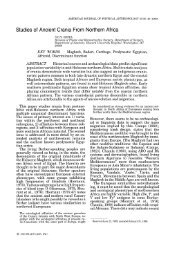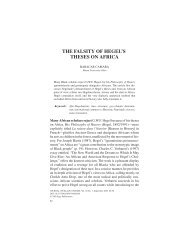Dutch Slavery and Slave Trade in the Indian Ocean
Dutch Slavery and Slave Trade in the Indian Ocean
Dutch Slavery and Slave Trade in the Indian Ocean
You also want an ePaper? Increase the reach of your titles
YUMPU automatically turns print PDFs into web optimized ePapers that Google loves.
164 journal of world history, june 2003<br />
ately until 1691 (approximately 1% growth annually), <strong>and</strong> stabiliz<strong>in</strong>g<br />
<strong>in</strong> <strong>the</strong> period afterward (1692–1708). 81<br />
In B<strong>and</strong>a, <strong>the</strong> orig<strong>in</strong>al population was deported, driven away,<br />
starved to death, or massacred by <strong>the</strong> company <strong>in</strong> 1621 <strong>and</strong> replaced<br />
by <strong>Dutch</strong> colonists or perkeniers us<strong>in</strong>g slave labor. The worst malaria<br />
epidemics generally followed volcanic eruptions. In 1638, 375 people<br />
died <strong>in</strong> Neira Town alone. In 1678, 376 people died <strong>in</strong> <strong>the</strong> <strong>Dutch</strong> government<br />
of B<strong>and</strong>a altoge<strong>the</strong>r. In 1693, 771 people died, <strong>in</strong>clud<strong>in</strong>g<br />
“very many slaves” <strong>in</strong> <strong>the</strong> nutmeg gardens or perken. In 1702, 351 free<br />
burgher slaves died <strong>and</strong> subsequently 356 had to be imported from<br />
eastern Indonesia <strong>in</strong> order to replace <strong>the</strong>m. 82<br />
Southwestern Ceylon was plagued by <strong>in</strong>termittent warfare <strong>and</strong><br />
hostilities with <strong>the</strong> <strong>in</strong>terior k<strong>in</strong>gdom of K<strong>and</strong>y (1670–75) <strong>and</strong> recurrent<br />
droughts or floods (1659, 1661, 1664, 1669, <strong>and</strong> 1673), spread<strong>in</strong>g<br />
fam<strong>in</strong>e <strong>and</strong> disease across <strong>the</strong> isl<strong>and</strong>. In 1661, for <strong>in</strong>stance, 900 slaves<br />
died, <strong>in</strong>clud<strong>in</strong>g 400 “old <strong>and</strong> nearly worn out people.” In 1669, large<br />
numbers of people were dy<strong>in</strong>g <strong>in</strong> <strong>the</strong> l<strong>and</strong>s of Colombo. The 100<br />
<strong>Dutch</strong>men <strong>and</strong> 800 slaves reportedly be<strong>in</strong>g treated <strong>in</strong> <strong>the</strong> local company<br />
hospitals were hardly better off, s<strong>in</strong>ce <strong>the</strong>se facilities were often<br />
virtual death traps. 83<br />
Batavia <strong>and</strong> its environs were <strong>the</strong> scene of several wars <strong>in</strong>volv<strong>in</strong>g<br />
<strong>the</strong> Javanese states of Mataram (1628–29, 1677–81) <strong>and</strong> Bantam<br />
(1619, 1633–39, 1656–59, 1680–83), <strong>and</strong> <strong>in</strong>creas<strong>in</strong>gly virulent diseases<br />
(especially malaria) due to natural <strong>and</strong> human-<strong>in</strong>duced changes<br />
<strong>in</strong> <strong>the</strong> local environment. Between 1676 <strong>and</strong> 1677, for <strong>in</strong>stance, dur<strong>in</strong>g<br />
hostilities <strong>in</strong>volv<strong>in</strong>g Mataram, <strong>the</strong> slave population <strong>in</strong>side Batavia<br />
decl<strong>in</strong>ed from 17,279 to 15,776. Between 1688 <strong>and</strong> 1690, diseases<br />
reduced <strong>the</strong> number of slaves <strong>in</strong>side <strong>the</strong> city (exclud<strong>in</strong>g <strong>the</strong> Zuidervoorstad)<br />
from 12,125 to 11,172. In August <strong>and</strong> September 1688 alone,<br />
over 1,000 people “of all nations” died <strong>in</strong> Batavia due to “an evil form<br />
of measles <strong>and</strong> smallpox.” High mortality rates <strong>in</strong> Batavia were com-<br />
81 Knaap, Kruidnagelen en Christenen, pp. 100–22; Van Dam, Beschryv<strong>in</strong>ge van de<br />
Oost<strong>in</strong>dische Compagnie, Tweede Boek, Deel I, pp. 132 et seq.<br />
82 Generale Missiven IV, p. 242; idem VI, p. 190; Hanna, Indonesian B<strong>and</strong>a, p. 85; Van<br />
Dam, Beschryv<strong>in</strong>ge van de Oost<strong>in</strong>dische Compagnie, pp. 177, 200–201.<br />
83 VOC 1236, OBP 1662, Miss. Gouvr. Laurens Pit en raad van Corom<strong>and</strong>el aan Batavia,<br />
11.2.1661; VOC 1234, OBP 1662, Miss. Comms. Van Goens te Colombo aan Batavia,<br />
5.4.1661; Generale Missiven, III, p. 716. See also S. Arasaratnam, <strong>Dutch</strong> Power <strong>in</strong> Ceylon,<br />
1658–1687 (Amsterdam, 1958), pp. 132–34; Van Dam, Beschryv<strong>in</strong>ge, p. 298; VOC 1292,<br />
OBP 1674, Miss Gouvr Van Goens de Jonge en raad van Ceijlon, 29.5.1673. In 1709, 300<br />
slaves perished with<strong>in</strong> 6 months allegedly due to overconsumption of alcohol. See Generale<br />
Missiven, VI, p. 622.




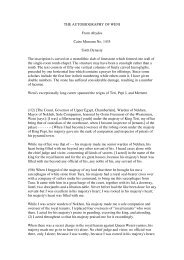
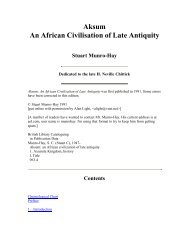
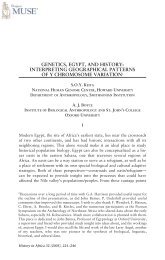

![The Negro trail blazers of California [microform] : a ... - Homestead](https://img.yumpu.com/32436613/1/174x260/the-negro-trail-blazers-of-california-microform-a-homestead.jpg?quality=85)

